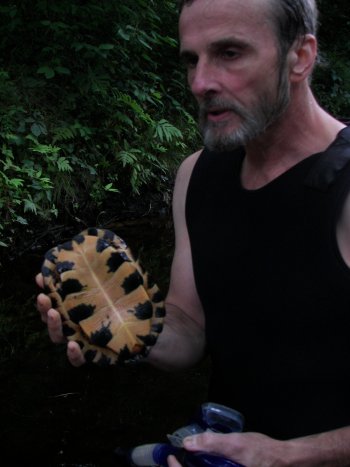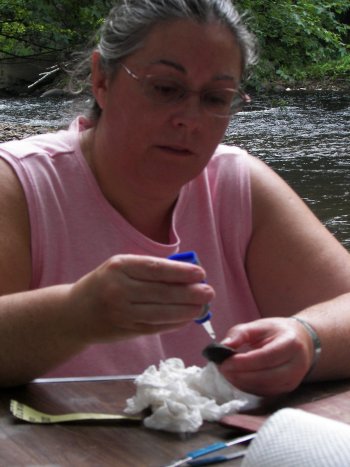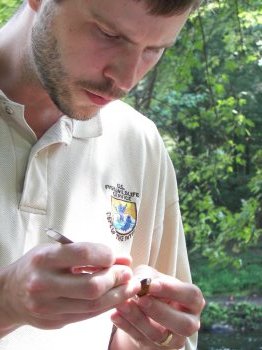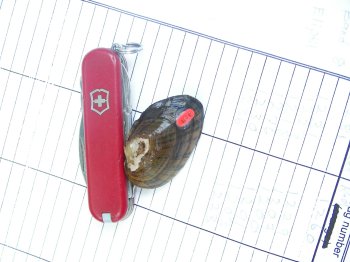New Hampshire Nature Notes
by Eric Orff
A 30th anniversary for me and returning threatened mussels to the Suncook River.
Friday 07/28/2006
Where have the years gone. It was thirty years ago today, Friday July 28, 1976 that I began my career with the state of NH. Not at the Fish and Game Department, but as a State Prison Guard trainee. I figured I at least would be in the state system and could visit the Fish and Game Department weekly instead of monthly trying to get a job there. And four months later it worked! In November of 1976 I was hired as a full time, but temporary fisheries bio-aid under a Squam Lake Bass Study Program. And the last thirty years has melted into history.
Here are some changes that have taken place in NH with wildlife since I was hired at Fish and Game:
1) A fledgling population of wild turkeys had been stocked about a year before. A total of 25 from NY. We now have over 30,000
2) The deer population was estimated around 42,000. We now have over 80,000+.
3) The bear population was about 1,200 to 1,500 and deckining. We now have an estimated 5,000 covering more area of the state than in 200 years.
4) Moose numbers were perhaps in the few hundreds. We now have 6,000.
5) No resident bald eagles or peregrine falcons. We now have close to a dozen nesting pairs of eagle and over a dozen falcons.
6) Coyotes had just entered the state around Colebrook in numbers. By 1980 they would sweep south and colonize all of the state.
7) About 1972 opossums moved into the state along the Mass. border and have marched northward almost to Coos County.
8) An Atlantic salmon restoration effort was under consideration in the Merrimack and Connecticut Rivers. Some progress there with about a hundred adults returning to each river each spring. Not the thousands expected by now.
9) A dozen or so nesting pairs of common terns in the state and no piping plovers. Over 2,000 nesting pairs on the Isle of Shoals now, plus very rare arctic and roseate terns. And 6 or 8 pairs of plovers down on the beaches.
10) A dozen or so pairs of nesting ospreys, all around Lake Umbagog. Now we have 40 or so pairs including close to a dozen in the Great Bay area.
And the best part of all this progress is, because NH is such a small state with a small staff of biologists, I have had a chance to work on each of these projects in one way or another. It has been such an exciting a rewarding 30 years!
And so it was Friday that I happened to be working on an all together different project for much of the day. Mussels. Yes state threatened brook floater mussels. St.Anslem professor Barry Wicklow called me to ask if I could round up some volunteers for returning the last 500 or so brook floater mussels to the Suncook River from the 1,100 that had been collected below the now dry river bed in Epsom. He was asking if I could get some local help. There had been a call for volunteers in the paper, through emails and I had asked Peter St. James to give it a shout on his morning radio show on WTPL in Concord Thursday morning.
I told Barry I could give him some time in the morning myself. So we waited for the volunteers to meet us at 9:00 am Friday at the location where the mussels would be returned to the river. And waited a while. Only a couple of volunteers showed up even though several had said they would. I got on my cell phone and called some locals including Mary Fougere, chair of the Friends of the Suncook River. She met us less than an hour later with her daughter Beth. By mid afternoon my friend and fellow river watcher Rick Hamlett arrived with his daughter Kasey. Except for a brief run to Concord, I ended up there much of the day as well.
Folks from the Fish and Wildlife Service Nashua Federal Fish Hatchery delivered the mussels to be returned to the river. Through the morning Barry was busy collecting the resident mussels to tag as well. A small set of numbered tags was super glued to each mussel in order for Barry to learn the survival of the residents versus transplanted mussels.
As it turns out according to Barry, who has been studying fresh water mussels for close to 20 years, the Suncook River has the largest known population of brook floater mussels of any river in the US. Elsewhere across the country, fresh water mussels are in a steep decline. Much of their biology has yet to be learned. Many will be lost BEFORE much is recorded or learned. So it felt especially good to be able to assist with this now well documented population. As Barry showed us how to age them, we were soon realizing that many were twenty years old or more.
A big bonus for us all Friday was the discovery by Rick Hamlett of a large male wood turtle as he snorkeled along distributing mussels. Barry aged it at about 15 years old. Just reaching sexual maturity. Few people realize how old some species of wildlife is, how it takes a decade of reproductive attempts to just replace themselves and how fragile their existence is. Many species may be tittering on the brink of extinction right here in NH. We just don't know. Maybe, just maybe the work I helped do today will make a difference with mussels in just this one river. I hope so.
Previous Note
2006-07-26
I remain toadless here but have seen them elsewhere and some great fishing fun.




